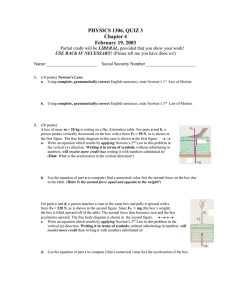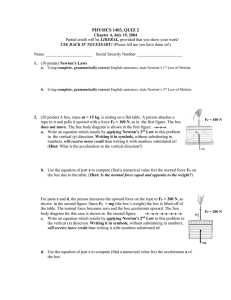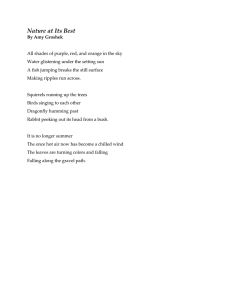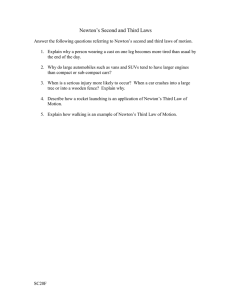The Mini Drop Lab
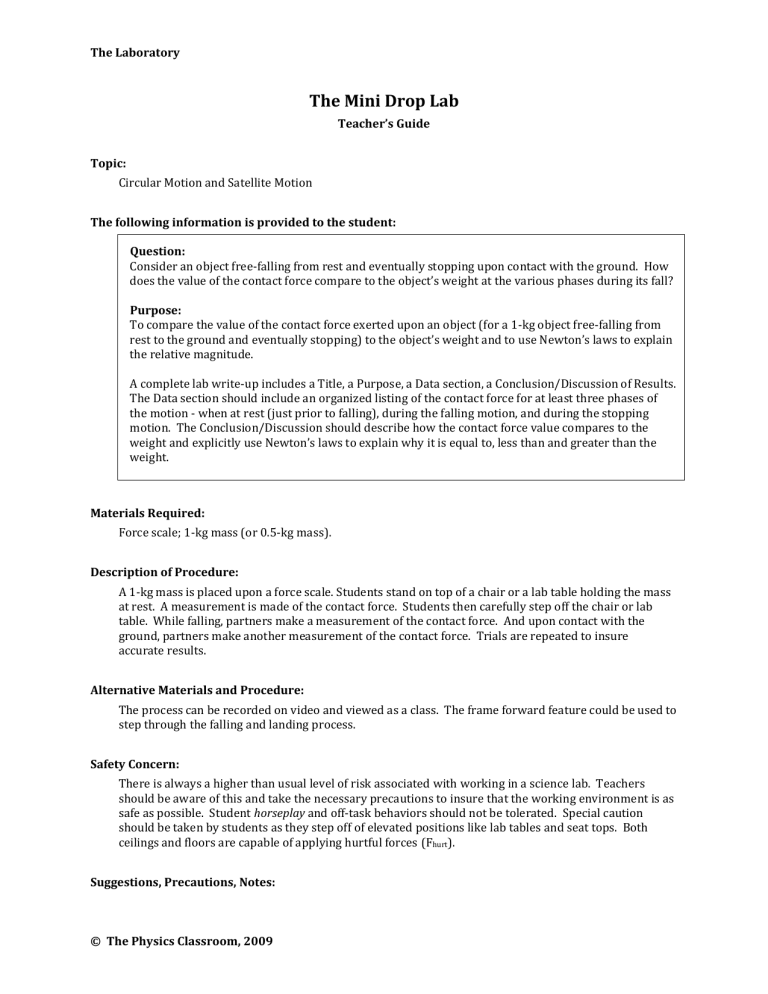
The Laboratory
Topic:
Circular Motion and Satellite Motion
The Mini Drop Lab
Teacher’s Guide
The following information is provided to the student:
Question:
Consider an object free-falling from rest and eventually stopping upon contact with the ground. How does the value of the contact force compare to the object’s weight at the various phases during its fall?
Purpose:
To compare the value of the contact force exerted upon an object (for a 1-kg object free-falling from rest to the ground and eventually stopping) to the object’s weight and to use Newton’s laws to explain the relative magnitude.
A complete lab write-up includes a Title, a Purpose, a Data section, a Conclusion/Discussion of Results.
The Data section should include an organized listing of the contact force for at least three phases of the motion - when at rest (just prior to falling), during the falling motion, and during the stopping motion. The Conclusion/Discussion should describe how the contact force value compares to the weight and explicitly use Newton’s laws to explain why it is equal to, less than and greater than the weight.
Materials Required:
Force scale; 1-kg mass (or 0.5-kg mass).
Description of Procedure:
A 1-kg mass is placed upon a force scale. Students stand on top of a chair or a lab table holding the mass at rest. A measurement is made of the contact force. Students then carefully step off the chair or lab table. While falling, partners make a measurement of the contact force. And upon contact with the ground, partners make another measurement of the contact force. Trials are repeated to insure accurate results.
Alternative Materials and Procedure:
The process can be recorded on video and viewed as a class. The frame forward feature could be used to step through the falling and landing process.
Safety Concern:
There is always a higher than usual level of risk associated with working in a science lab. Teachers should be aware of this and take the necessary precautions to insure that the working environment is as safe as possible. Student horseplay and off-task behaviors should not be tolerated. Special caution should be taken by students as they step off of elevated positions like lab tables and seat tops. Both ceilings and floors are capable of applying hurtful forces (F hurt
).
Suggestions, Precautions, Notes:
© The Physics Classroom, 2009
The Laboratory
1. This lab is nearly identical to the Normal Force-o-meter Lab done in the Newton's Laws unit.
2. Students will likely perceive the force scale as measuring the weight of the object. Remind students that scales do not technically measure an object's weight. They always measure the upward force applied to the mass; this upward force is only equal to the weight when the object is at equilibrium. When an object is accelerating, the upward force is not equal to the weight.
3. Remind students of the importance of safety when climbing on and stepping off of chairs and lab tables. Monitor students and intervene when safety becomes forgotten.
4. An interesting application of this lab is a discussion of NASA's vomit comet. Information can be found on the internet and some videos are available through YouTube. For instance, see NASA's
Brain Bites or a well-done video from NASA's MicroGravity University .
Auxiliary Materials:
None
Scoring Rubric:
CG10. The Mini Drop Lab
Included, labeled and organized all parts of the lab report.
Data section includes a clear and organized listing of contact force values for the three phases of its fall; units are indicated.
Conclusion/Discussion compares the contact force to the object’s weight for the three indicated phases of its motion; discussion is clear. Newton’s second law is explicitly used to relate the conditions of the motion (at rest, free falling, etc.) to the relative size of the two forces.
Score
_____/_____
Connections to The Physics Classroom Tutorial:
The following reading is a suitable accompaniment to this lab: http://www.physicsclassroom.com/Class/circles/u6l4d.cfm
Connections to Minds on Physics Internet Modules:
Sublevel 9 of the Circular and Satellite Motion module is a suitable accompaniment to this lab: http://www.physicsclassroom.com/mop/module.cfm
© The Physics Classroom, 2009
